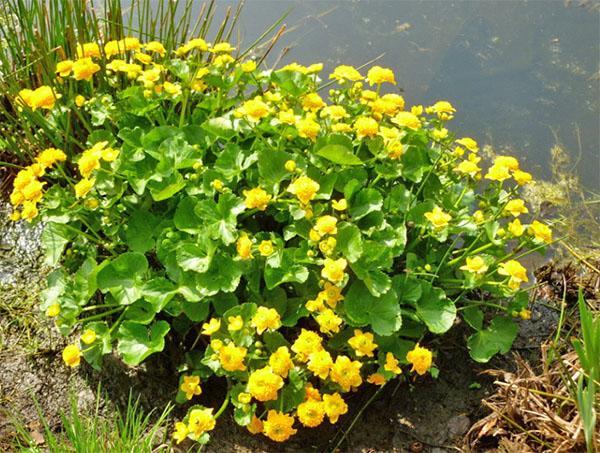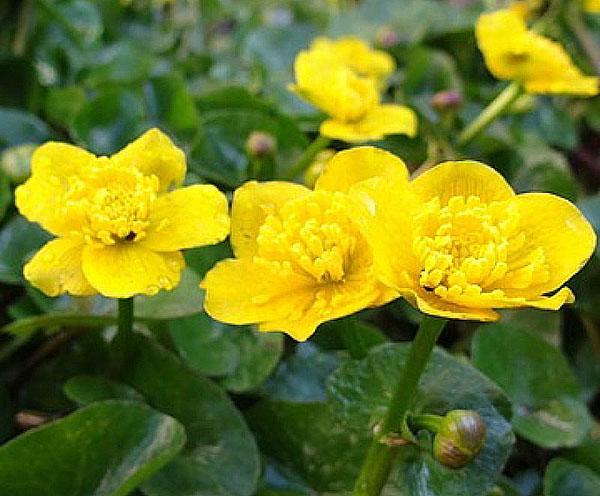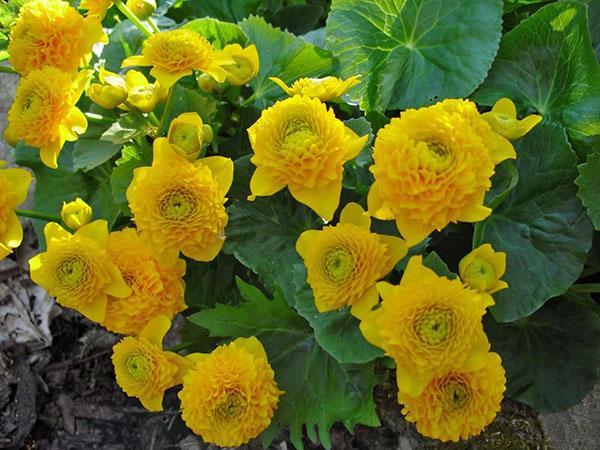Bright colors of the garden in the marsh marigold
 With the arrival of spring, bright yellow primroses appear in the meadows. Beautiful squat bushes, a rounded hat of elegant flowers. This marigold, which is widely used not only as an ornamental plant, and as a remedy in medicine.
With the arrival of spring, bright yellow primroses appear in the meadows. Beautiful squat bushes, a rounded hat of elegant flowers. This marigold, which is widely used not only as an ornamental plant, and as a remedy in medicine.
Marsh marigold: photo and description

The root is represented by filamentous roots, collected in a single bunch.
The plant has an erect, naked, very fleshy and leafy stem. As a rule, it is ascending or ascending. Sometimes there are specimens with recumbent. In adulthood, the height of the bush reaches approximately 40 cm.
The foliage is shiny, whole, naked, has a regular arrangement, heart-shaped or kidney-shaped and dark green in color. The edge is crenate or crenate. The bracts are sessile, and the basal foliage is located on long petioles and measures up to 20 cm in width. But the stem leaves have a fleshy structure.
The flowering of the marigold (photo is presented in the article) occurs in April-May with the blooming of buds on long peduncles in the amount of 7 pcs. on the bush. Flowers consist of 5 petals and a simple perianth, 2-12 pcs. pistils and many stamens and are colored golden orange or bright yellow, color.
After flowering, the multileaf fruit ripens. Moreover, their number is the same as the number of pistils was originally. At the end of each leaflet there is a tail, and inside there are about 10 black seeds. The fruit fully ripens in May-June, after which it opens and the seeds fall to the ground.
You need to be very careful with the plant, since the ground part is poisonous. Therefore, it is strictly prohibited to consume any portions raw. But after cooking, the toxic substances inside are destroyed, and the plant becomes harmless to health.
Terry variety
 Terry marigold is another popular variety for the beauty of the flower. The most famous varieties: Plena, Multiplex, Flore Pleno, which have large, up to 5 cm in diameter, double buds of bright yellow color. Moreover, the terry is so strong that in appearance the flower can be confused with a small dahlia.
Terry marigold is another popular variety for the beauty of the flower. The most famous varieties: Plena, Multiplex, Flore Pleno, which have large, up to 5 cm in diameter, double buds of bright yellow color. Moreover, the terry is so strong that in appearance the flower can be confused with a small dahlia.
Marsh marigold: planting and care
The beauty of the plant will delight the eye only when properly planted and grown. Consider the basic requirements of the marigold:
- Lighting and soil. It is best to place the flower together with good illumination or weak partial shade. Moreover, it is desirable near water bodies, since marigold requires a rich and perfectly moisturized substrate.
- Temperature conditions. The plant does not express any special temperature requirements. The only thing is that it is frost-resistant, so even young animals can easily endure winter without shelter.
- Watering. With the onset of heat, the plant should be watered fairly abundantly. This is also done during the growing season.
- Humidity. This parameter is very important for the plant. It should be pretty tall. If the humidity drops even for a short time, this will greatly affect the decorativeness of the plant. When choosing a planting site, pay attention to loam.At the same time, make sure that it does not dry out, much less dry out.
- Top dressing. With the arrival of spring, the marigold is fed with organic fertilizers. I mulch the bushes before winter. Before flowering, fertilizing is carried out with mineral fertilizers, which will not only provoke abundant flowering, but also lush flowering.
- Transfer. Kaluzhnitsa perfectly tolerates a new place of residence, so you can replant it without fear. This should be done at any time during the growing season, but preferably in March or September.
Control watering based on soil conditions. Dried up - water.
Marsh marigold description of reproduction
 The plant reproduces in several ways:
The plant reproduces in several ways:
- By dividing the bush during transplanting in autumn or spring. To do this, the plant is dug up together with the root, divided into bushes of equivalent roots and planted in their own holes. Further, the plants are shaded from bright rays, watered abundantly and protected by goths of wind.
- Cuttings. During the summer, they are cut and then rooted in the ground.
- Nodular rooting. With the onset of spring, a stem layering is made (they simply bend the stem to the ground and attach it with a "bracket") Roots appear in this node over time, and by the fall a separate bush is formed, which can then be separated from the mother plant in spring and transplanted permanently into its hole ...
- There is also a seed reproduction method.
Application
Since marigold has not only decorative, but also medicinal value, we will consider two options for its use.
Medical
The plant is widely used in medicine. Since the plant is poisonous, it is used in different collections in a minimum amount (leaves, stems, flowers in the state of buds are used). The medicinal properties of marigold are as follows:
- Helps with diseases of the respiratory system (asthma, whooping cough, fever, bronchitis).
- Has analgesic, diuretic, anti-inflammatory and anticonvulsant, strong antibacterial properties.
- It is used for dropsy, rheumatism, scrofula.
- Often prescribed for the treatment of burns, inflammations, wounds.
- It is used for diseases of the urinary tract.
- Relieves women with painful menstruation.
- Plant juice is an excellent emetic and laxative.
Design solutions
 Kaluzhnitsa is an early flowering plant. It is not surprising that landscape designers love it and widely use it to decorate gardens, parks, curbs, flower beds. This is an excellent plant for decorating reservoirs, both natural and artificial. Growing well in foliage, the plant will become a real decoration of the coast.
Kaluzhnitsa is an early flowering plant. It is not surprising that landscape designers love it and widely use it to decorate gardens, parks, curbs, flower beds. This is an excellent plant for decorating reservoirs, both natural and artificial. Growing well in foliage, the plant will become a real decoration of the coast.
When planting plants in the vicinity of other types of flora, one should select such specimens that have similar characteristic data and similar flowering times. This is necessary so that the flowers do not obscure each other. The fading of the marigold is also taken into account: in front of it, you need to plant specimens that bloom a little later or have late foliage blooming.
Kaluzhnitsa adjoins beautifully with krasodnev, the softest lungwort, Chinese astilba, snake mountaineer, host, thick-leaved badan, alpine forget-me-not, ostrich.
Knowing all the intricacies of planting and growing marigold, you can decorate your pond or garden area. Just do not forget that the plant is poisonous and wash your hands thoroughly after work.